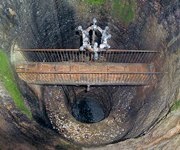


This well, which is fed by underground springs, was probably the main water tank of the Etruscan city. Its rim was then at street level, but it is now some way underground. The construction of the stone cladding is similar to that of the Etruscan city walls, suggesting that both belong to the same era.
Excavations in 1965 revealed that the stone-clad cylinder is at least 37 meters deep. The diameter starts at about 6 meters, reducing by a half after some 12 meters.
[The well is closed for refurbishment ?]
Another Etruscan well (3rd century BC) that was discovered in Via Cesare Caporali (see Walk VII) cannot be visited. Its construction is apparently similar to this well in Piazza Danti, and it is interesting to note that both were sunk just inside the walls of the Etruscan city.
Palazzo Bourbon di Sorbello was built over the site of the well in the 16th century. The well was used to feed the public fountain at the centre of what is now Piazza Piccinino until the Second World War.

